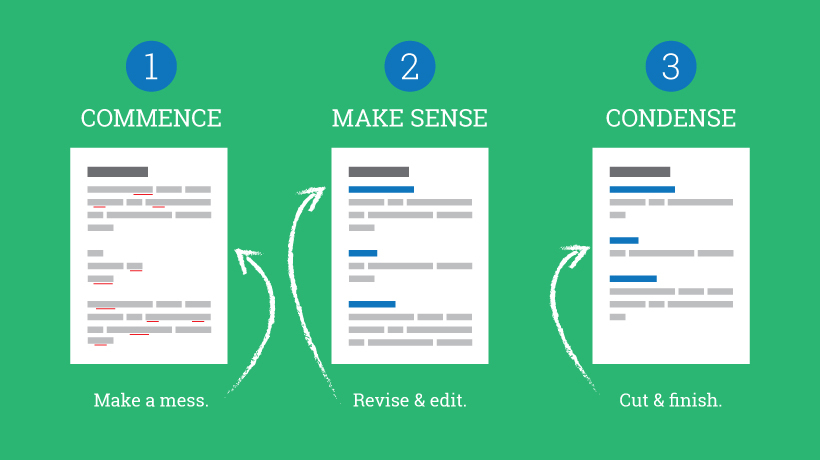Reframing The Standard Writing Process
Back in high school, English was definitely not my best subject. I didn't enjoy reading and was horribly embarrassed about my (complete lack of) writing skills. However, after many years of authoring scripts for eLearning courses, developing training publications, authoring white papers, and a bazillion emails later, my writing skills have slowly but surely improved. Whether you're writing an eLearning script, an email, or an article, I've found this simple three-stage writing process to be super useful. Yes, I'm aware that there is a well-established writing process, one that I utilize regularly. Still, I've found the reframing of that process into these three stages to be a simpler, less-daunting approach to get my staff, students, and myself to have a little less fear of writing.
3-Stages Of Writing
- Commence
- Make Sense
- Condense
Easy, right?! (...and it rhymes).
Okay, now that I've commenced (see how I did that?), let me move on to making sense.
Stage 1: Commence
It's as simple as it sounds—just get started! But I get it, just taking that first step can often be the hardest part. Don't worry, it's not only you that feels this way. Do a quick search for "Why is it difficult to start…" and Google will auto recommend similar questions and thousands of articles on the subject. (I like this one.)
When you commence writing, it helps to start by managing your own expectation that it doesn't have to be perfect, ordered, or even understandable. Just start putting all of your ideas on paper—or typing them into your word processor of choice—whatever works for you. For your first draft, it's okay for it to be a bit messy and over-bloated with ideas, words, and poor grammar. Don't get trapped by the urge to constantly edit your work (admittedly, I'm doing it right now). You'll have plenty of opportunity for that later.
One of the easier and probably most efficient ways to start is to list the main ideas that you want to cover. This will help you later in the process by ensuring that you've included everything you intended to cover. As a bonus, in this more primitive form, it's easier to establish the order of ideas as they should unfold in your writing.
Once you think you've got most of your ideas down, you're ready to move to stage two.
(Considering the traditional writing process, this stage includes the steps Prewriting and Drafting.)
Stage 2: Make Sense
Okay, you've finished your first draft. The hardest part is over! It's now time to revisit those earlier urges to fix everything. This stage isn't necessarily pain-free, but once you have something to work from, it's a lot easier to move forward. During this stage, you will likely revisit and revise your content many times. Just keep working at it. Similar to sculpting, keep carving and adding as appropriate, and your content will start to take shape.
Other than spelling and grammar (which should be a given), take a moment to consider your target audience.
Ask yourself:
- Am I using the right tone (i.e., informal, formal, conversational, etc.)?
- Are my ideas in the right order?
- Do I need to expand upon or simplify the concepts?
- Do all of my ideas have the appropriate background and context?
Ultimately, other than cleaning up your text, you want to focus on making the content relevant and interesting for your intended learners.
(Considering the traditional writing process, this stage includes the steps Revising and Editing.)
Stage 3: Condense
Okay, yes, this could technically be a part of the previous stage; however, the exercise of reducing your text is important enough that it warrants special attention.
While you're writing, you may have unintentionally included content that initially seemed relevant; however, the inclusion of this type of content will inhibit your learner from focusing on what's truly important.
In my experience, it's rare for learners to express appreciation for additional mandatory content, especially in an eLearning course. Your best bet is to get to the point and provide links to other resources as appropriate, enabling the learner to dig deeper (if they so choose).
So, depending on what you're writing, here are a few things to consider:
- Does my script contain too much good-to-know (unessential) information?
- Have I repeated myself or expounded a little too much?
- Are my examples helpful or encumbering?
Putting It Into Action
Today, I started writing this by, well, just starting. I had an idea of what I wanted to share and just started typing. Once I had the majority of my thoughts written, I circled back to revise and edit over and over again. Once everything was generally cleaned up, I read through it a few more times, cutting out anything that wasn't necessary.

